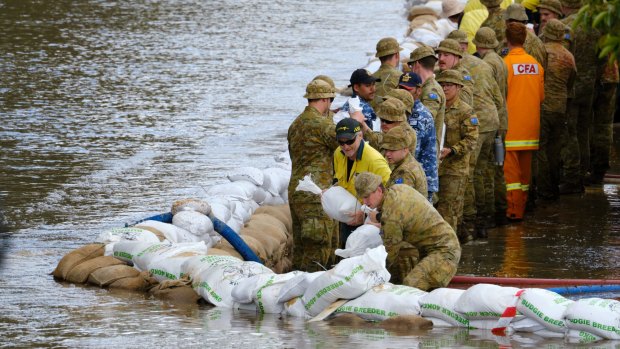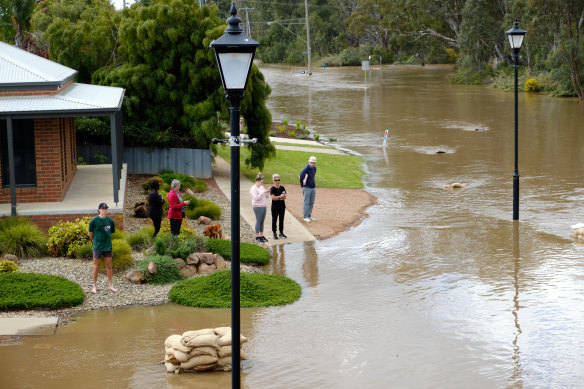Our live coverage of the extreme weather is free for all readers. Please consider supporting our journalism with a subscription.
Echuca residents are racing to build a two-and-a-half-kilometre levee to protect their town from the Murray River when it’s expected to flood later this week, as businesses close and supplies run low.
While homes have already been inundated by the Campaspe River, the Murray River is likely to exceed the major flood level of 94.4 metres (Australian height datum) on Thursday. The Bureau of Meteorology predicted the river could peak at 95 metres on Friday.
CFA, army, and airforce personnel are working together on sandbagging in Echuca West to help divert river flooding and save houses.Credit:Erin Jonasson
Bureau of Meteorology forecaster Miriam Bradbury expects thunderstorms and widespread rain on Thursday, which could lead to further flash flooding on and north of the Victorian ranges. The highest forecast rainfall totals were expected to be between 10 and 30 millimetres.
There were 13 major emergency warnings active as part of Victoria’s flood crisis on Tuesday morning.
As of 6am on Tuesday, residents of Echuca, Charlton, Bunbartha, Zeerust, Mundoona and Kaarimba in Victoria’s north were advised to evacuate their homes immediately.
Those in Shepparton, Mooroopna, Orrvale, Murchison and Kialla West were told it was too late to leave their properties, and were advised to seek shelter at the highest possible location.
Campaspe Shire mayor Chrissy Weller said it was possible a “couple of thousand” homes in Echuca would be inundated in coming weeks, and the Australian Defence Force was working with Echuca residents to limit the damage by getting the levee built with sandbags and mud.
Echuca residents watch the flood roar down Campaspe Esplanade on Sunday.Credit:Erin Jonasson
“The Goulburn River is coming into the Murray, and that’s what’s coming here, so we know we’ve only got perhaps around 24 hours, maybe a little bit more,” Weller said.
“We’ve got to give it a go because, obviously, we’ll lose all the residential and the CBD area if we don’t.”
More than 900 homes in the nearby town of Rochester have been inundated with floodwaters.
Emergency Management Victoria is warning that anyone in affected areas who chooses to stay could become isolated for a number of days, and emergency services workers may not be able to assist them.
Murray Watt, the federal emergency services minister, announced that residents of a further nine municipalities were now eligible for one-off flood relief payments. As of 2pm Tuesday, there will be 14 council areas where residents affected by the floods can claim the $1000 payment per adult or $400 per child. The municipalities now included are Bendigo, Benalla, Moonee Valley, Mount Alexander, Boroondara, Central Goldfields, Loddon, Murrindindi and Yarra.
Watt said he expected more council areas would be added in the next 24 hours.
One-off flood payments were already available in Campaspe, Greater Shepparton, Maribyrnong, Mitchell Shire and Strathbogie.
There is also a 13-week disaster relief allowance, which is available in a wider range of council areas and is particularly for people who have lost income due to the floods.
“The disaster recovery allowance, that tends to be guided by areas the Victorian government has decided are disaster zones. As this flooding extends into further areas of the state, I’d expect those payments would be available more widely,” Watt said.
Watt also said there needed to be a conversation about government-funded buybacks of homes or properties affected by floods.
“The prime minister’s made this point as well: we do need to do something about planning and development in this country. [Otherwise] we will continue to see too much development approved in disaster-prone regions, and then we all end up sharing the burden of the repair costs, and it’s devastating for those people who lose their homes,” he said.
Meanwhile, food prices are expected to rise because of the impact of the floods on Victoria and the Murray Darling Basin, considered the “food bowl of Australia”.
Professor Tony Bacic, director of La Trobe Institute of Agriculture and Food told ABC Melbourne the sector was headed for a bumper crop harvest before the floods hit. A recent report found natural disasters had the capacity to diminish the state’s supplies to just five days’ of fresh produce.
He said there was a need to invest in transport systems and supply chains that weren’t exposed to weather events, and to invest in local manufacturing.
“If we were completely isolated from the world we would have 30 days of non-perishable food supply in the country. We have now realised this is a sovereign security risk as well,” he said.
The Morning Edition newsletter is our guide to the day’s most important and interesting stories, analysis and insights. Sign up here.
Most Viewed in National
From our partners
Source: Read Full Article



